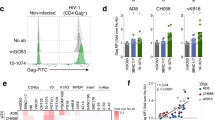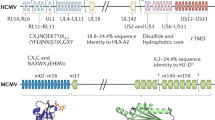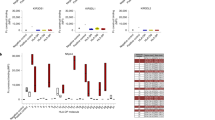Abstract
THE molecular basis of recognition and target cell killing by cytotoxic T cells is still unknown. Doherty and Zinkernagel showed that mouse cells infected with lymphocytic choriomeningitis virus can be lysed by immune cytotoxic T cells but only if both cell types share at least part of the major histocompatibility (H–2) region (see ref. 1). H–2 compatibility is also required for cell killing in other viral systems2–4, and for cells carrying non-viral antigens5–7. Our aim is to analyse the virus specificity of cytotoxic T cells, and the nature of their antigen recognition units. This requires a virus system with a small number of well characterised protein components, amenable to biochemical and genetic manipulation, as well as cytotoxic cells that will lyse target cells in a short term assay to minimise nonspecific cytotoxicity. Influenza virus offers many advantages for this type of study. The virion contains only two well characterised surfaced antigens, haemagglutinin (H) and neuraminidase (N), that are also expressed on the surface of infected cells8–11, and can be purified in quantity. Virus strains are available with serologically distinct surface proteins, and with different internal proteins12,13. Here we describe the generation of potent cytotoxic cells that are specific for histo-compatible influenza virus-infected cells, but exhibit extensive cross-reactivity between the different type A influenza virus strains.
This is a preview of subscription content, access via your institution
Access options
Subscribe to this journal
Receive 51 print issues and online access
$199.00 per year
only $3.90 per issue
Buy this article
- Purchase on Springer Link
- Instant access to full article PDF
Prices may be subject to local taxes which are calculated during checkout
Similar content being viewed by others
References
Doherty, P. C., Blanden, R. V. & Zinkernagel, R. M. Transplantation Rev. 29, 89–124 (1976).
Koszinowski, U. & Ertl, H. Nature 255, 552–554 (1975).
Blanden, R. V. et al. Nature, 254, 269–270 (1975).
Doherty, P. C. & Zinkernagel, R. M. Immunology 31, 27–32 (1976).
Bevan, M. J. J. exp. Med. 142, 1349–1364 (1975).
Gordon, R. D., Simpson, E. & Samelson, L. E. J. exp. Med. 142, 1108–1120 (1975).
Schmitt-Verhulst, A. M. & Shearer, G. M. J. exp. Med. 142, 914–927 (1974).
Laver, W. G. & Valentine, R. C. Virology 38, 105–119 (1969).
Laver, W. G. Virology 45, 275–288 (1971).
Wrigley, N. G., Skehel, J. J., Charlwood, P. A. & Brand, C. M. Virology 51, 525–529 (1973).
Skehel, J. J. & Waterfield, M. D. Proc. natn. Acad. Sci. U.S.A. 72, 93–97 (1975).
Skehel, J. J. in Evolution in the Microbial World (eds Carlile, M. J. & Skehel, J. J.) 321–341 (Cambridge University Press, Cambridge, 1974).
Compans, R. W. & Choppin, P. W. in Comprehensive Virology 4, (eds Fraenkel-Conrat, H. & Wagner, R. W.) 179–252 (Plenum, New York, 1975).
Cerottini, J. C., Engers, H. D., Robson, H., MacDonald, H. R. & Brunner, K. T. J. exp. Med. 140, 703–717 (1974).
Häyry, P. & Andersson, L. C. Scand. J. Immun. 3, 823–832 (1974).
Dunlop, M. B. C. & Blanden, R. V. Immunology 31, 171–180 (1976).
Yap, K. L. & Ada, G. L. Immunology 32, 151–160 (1977).
Gardner, I. D. & Blanden, R. V. Cell. Immun. 22, 283–296 (1976).
Bull. Wld Hlth Org. 45, 119 (1971).
Kilbourne, E. D. Bull. Wld Hlth Org. 41, 643 (1969).
North, J. R. & Askonas, B. A. Eur. J. Immun. 6, 8–15 (1976).
Simpson, E., Gordon, R., Taylor, M., Mertin, J. & Chandler, P. Eur. J. Immunol. 5, 451–455 (1975).
Raff, M. C. Nature 226, 1257–1258 (1970).
Cambridge, G., Mackenzie, J. S. & Keast, D. Inf. Immun. 13, 36–43 (1976).
Effros, R. B., Doherty, P. C., Gerhard, W. & Bennink, J. J. exp. Med. 145, 557–568 (1977).
Author information
Authors and Affiliations
Rights and permissions
About this article
Cite this article
ZWEERINK, H., COURTNEIDGE, S., SKEHEL, J. et al. Cytotoxic T cells kill influenza virus infected cells but do not distinguish between serologically distinct type A viruses. Nature 267, 354–356 (1977). https://doi.org/10.1038/267354a0
Received:
Accepted:
Issue Date:
DOI: https://doi.org/10.1038/267354a0
This article is cited by
-
Extensive T cell cross-reactivity between diverse seasonal influenza strains in the ferret model
Scientific Reports (2018)
-
Influenza‐induced lung Trm: not all memories last forever
Immunology & Cell Biology (2017)
-
Harnessing alveolar macrophages for sustained mucosal T-cell recall confers long-term protection to mice against lethal influenza challenge without clinical disease
Mucosal Immunology (2014)
-
Cellular immune correlates of protection against symptomatic pandemic influenza
Nature Medicine (2013)
-
Return of inactivated whole‐virus vaccine for superior efficacy
Immunology & Cell Biology (2012)
Comments
By submitting a comment you agree to abide by our Terms and Community Guidelines. If you find something abusive or that does not comply with our terms or guidelines please flag it as inappropriate.



